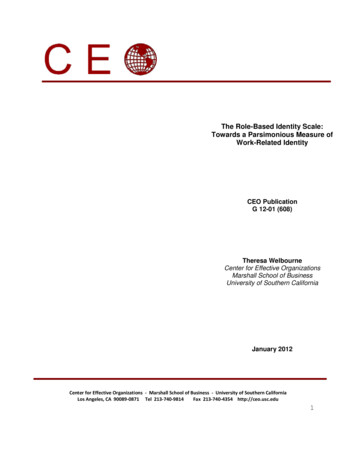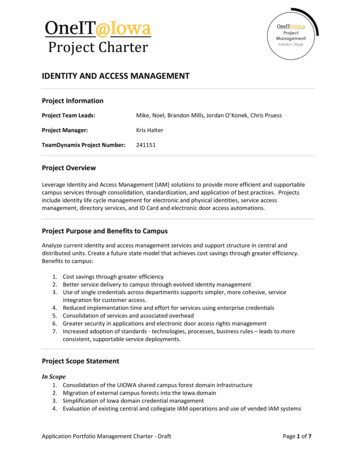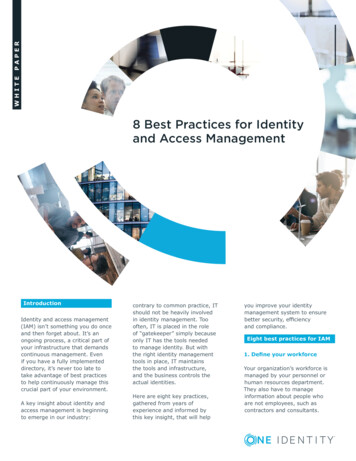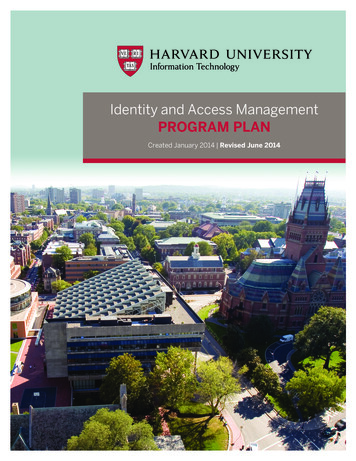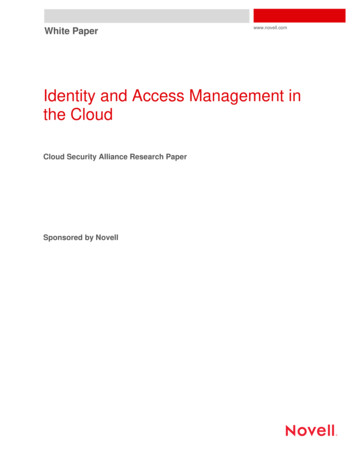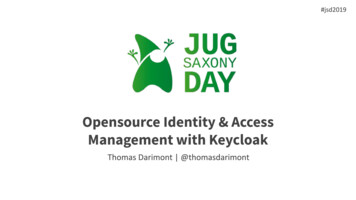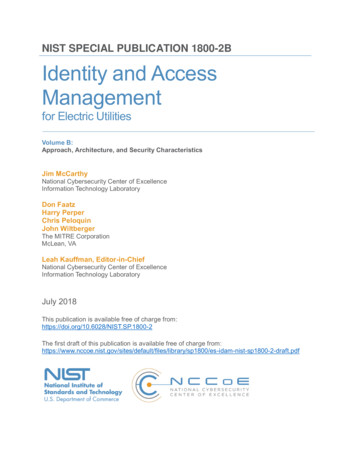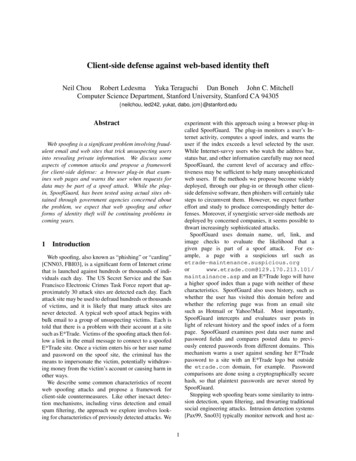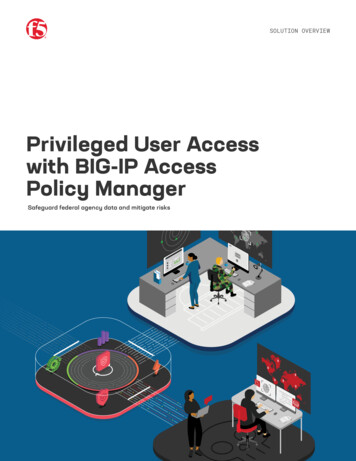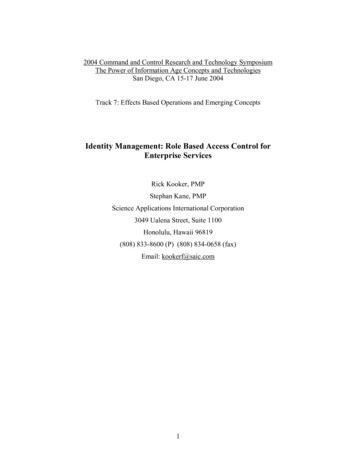
Transcription
2004 Command and Control Research and Technology SymposiumThe Power of Information Age Concepts and TechnologiesSan Diego, CA 15-17 June 2004Track 7: Effects Based Operations and Emerging ConceptsIdentity Management: Role Based Access Control forEnterprise ServicesRick Kooker, PMPStephan Kane, PMPScience Applications International Corporation3049 Ualena Street, Suite 1100Honolulu, Hawaii 96819(808) 833-8600 (P) (808) 834-0658 (fax)Email: kookerf@saic.com1
Form ApprovedOMB No. 0704-0188Report Documentation PagePublic reporting burden for the collection of information is estimated to average 1 hour per response, including the time for reviewing instructions, searching existing data sources, gathering andmaintaining the data needed, and completing and reviewing the collection of information. Send comments regarding this burden estimate or any other aspect of this collection of information,including suggestions for reducing this burden, to Washington Headquarters Services, Directorate for Information Operations and Reports, 1215 Jefferson Davis Highway, Suite 1204, ArlingtonVA 22202-4302. Respondents should be aware that notwithstanding any other provision of law, no person shall be subject to a penalty for failing to comply with a collection of information if itdoes not display a currently valid OMB control number.1. REPORT DATE3. DATES COVERED2. REPORT TYPEJUN 200400-00-2004 to 00-00-20044. TITLE AND SUBTITLE5a. CONTRACT NUMBERIdentity Management: Role Based Access Control for Enterprise Services5b. GRANT NUMBER5c. PROGRAM ELEMENT NUMBER6. AUTHOR(S)5d. PROJECT NUMBER5e. TASK NUMBER5f. WORK UNIT NUMBER7. PERFORMING ORGANIZATION NAME(S) AND ADDRESS(ES)Science Applications International Corporation,3049 Ualena Street Suite1100,Honolulu,HI,968199. SPONSORING/MONITORING AGENCY NAME(S) AND ADDRESS(ES)8. PERFORMING ORGANIZATIONREPORT NUMBER10. SPONSOR/MONITOR’S ACRONYM(S)11. SPONSOR/MONITOR’S REPORTNUMBER(S)12. DISTRIBUTION/AVAILABILITY STATEMENTApproved for public release; distribution unlimited13. SUPPLEMENTARY NOTESThe original document contains color images.14. ABSTRACT15. SUBJECT TERMS16. SECURITY CLASSIFICATION OF:17. LIMITATION OFABSTRACTa. REPORTb. ABSTRACTc. THIS PAGEunclassifiedunclassifiedunclassified18. NUMBEROF PAGES19a. NAME OFRESPONSIBLE PERSON30Standard Form 298 (Rev. 8-98)Prescribed by ANSI Std Z39-18
"Effective systems management depends primarily on . . . implementation of policy-basedmanagement. You simply cannot count on technology alone to see you through."Network and Systems Managers’ Best Practices Report 2004ABSTRACTThe current Department of Defense (DoD) Network consists of separate domains, disparatenetworks that are geographically dispersed, and resourced by hundreds of diverse funding sources.As we move into a Network Centric DoD Enterprise and as Web and data services becomeavailable throughout the DoD Network with applications becoming Enterprise wide, anunreasonable burden will be placed on the service providers to research and gather the appropriatedata to determine if users requesting access should be authorized that access. A most challengingproblem in managing large distributed systems is the complexity of security administration. Sincemost applications are not yet available as Web Services but rather still controlled within a certainlocalized command or enclave, the issue of authorization is manageable albeit error prone andexpensive. DoD transformation to a Network Centric environment requires robust authenticationof users and Web Services for C2 based on PKI/biometric technology and subsequentauthorization/Access to data/services/applications provided by an Enterprise Role Based AccessControl (ERBAC) system. This paper is designed to convey information to the audience of theimportance, necessity, and urgency associated with the problem, the need to commit resources fora solution and subsequently working within that solution across the DoD enterprise.2
PROBLEMThe National Institute of Standards and Technology (NIST) defines role-based access as when:“access decisions are based on the roles that individual users have as part of an organization.”This discussion concedes that there are more than a few technically sophisticated andthoroughly operable Identity Management (IdM) solutions fully capable of providing the means toimplement a successful Enterprise RBAC. There is no lack of approaches involving DirectoryServices, hierarchical role inheritance schemas, biometric and Public Key Infrastructure (PKI)authentication standards, Single Sign On (SSO) solutions, Security Assertion Markup Language(SAML) assertions, etc. The actual discussion here is more from the Operational perspectiverather than from a Systems or Technical viewpoint.So far, most of the basic RBAC development efforts have been initiated and supported bythe DoD. In the past DoD requirements were primarily aimed at preventing the unauthorizedaccess to classified information, and now more recently, the commercial world has becomeinvolved due to Privacy Act concerns, Health Insurance Portability and Accountability Act(HIPAA) patient record confidentially, liabilities, and the increased cost of systems administration.There are two fundamental types of access control: Discretionary Access Control (DAC)and Mandatory Access Control (MAC). DAC permits the granting and revoking of access controlprivileges to be left to the discretion of the individual users or organizations. A DAC mechanismallows users to grant or revoke access to any of the systems/applications under their control. DACis normally implemented based on some locally (individual data owner or organization)determined formula derived from some combination of data ownership and the requestingindividuals job functions that might require access to that data.MAC, as defined in the DoD'sTrusted Computer Security Evaluation Criteria (TCSEC), is "A means of restricting access toobjects based on the sensitivity (as represented by a label) of the information contained in theobjects and the formal authorization (i.e. clearance) of subjects to access information of suchsensitivity." The current DoD Enterprise Access Control schema seems to reflect a somewhatarbitrary blend of DAC/MAC loosely overlying the “rugged individualism” as currently practicedwithin each of the branches of Services in DoD.In the past, the pre-Network Centric Enterprise Services (NCES) DoD C2 and InformationManagement (IM) environment was defined by sheer distances, “trusted” systems, large3
organizational structures with very vertical and limited Communities of Interest/Communities ofPractice (COI/COPs), centralized decision making processes with relatively few decision makers,and a limited availability of timely data, all of which mandated an environment populated byrelatively static “roles” for participants, particularly in terms of geographic location andorganization.Even today’s DoD Enterprise Network is still primarily one of separate domains/enclaves,disparate networks that are geographically dispersed and are resourced by a multitude of diversefunding sources/services. The limiting factor in our Network Centric Warfare Operation is nowcomplexity, not lack of bandwidth, computing power, or timely data as in the past.ThisTransformational technology is rapidly forcing all of us into a Network Centric DoD Enterprisebased on Web based technology characterized by “death to distance”, rapid acquisition of vastamounts of timely information, very extensive COIs/COPs, and transition to a Service OrientedArchitecture (SOA).There is already a growing litany of IM innovations occurring asTransformation gains momentum throughout the DoD.As customers on the DoD Enterprise become aware of the plethora of the existingapplications/services, the System Administrators and Central Design Authorities (CDAs) for thoseapplication/services are quickly confronted with an exponential growth in the numbers ofprospective users of their applications/services. This phenomenal growth is rarely accompaniedwith adequate funding or technological refreshment to support the increased base of customers.Some recent efforts such as Army Knowledge Online (AKO), Navy Marine Corps Intranet(NMCI) and Task Force Web (TFWeb) have provided lessons learned and valuable direction forapplication/data owners on what happens when users increase from thousands to tens or hundredsof thousands and how to construct Web Services and applications to ensure their availabilitythroughout the DoD Enterprise. However, relatively little has been accomplished in the planningfor controlling access to those applications/services.As Web Services become available throughout the DoD Network and applications becomeEnterprise wide, an unreasonable burden is being placed on the service providers/systemadministrators to research, gather, and sometimes, verify the appropriate personal/Command datanecessary in order to make a determination regarding authorization of a user’s request for access.Today, security administration is often costly and prone to error partially because manyapplications/systems utilize static Access Control Lists (ACLs) to link an individual’s access with4
each resource on the system by means of “forms based” logins. Despite the growing use of “semiautomated self-sign up registration, email back password” approaches for some applications, thecurrent process for validating users “need to know” is labor intensive, sporadic, error prone, andperformed solely by the data/applications/systems owner, CDA, responsible for each user accessrequest. Rarely, if ever, are users forced to update USERIDs or passwords on DoD systems. So,when granted access to an application/system, the user usually ends up having access “forever”,despite possible subsequent alterations of his/her “need to know”, level of security clearances,retirement from DoD, etc.In the case of one of the authors, it was surprising to discover thataccess on one of the Navy’s Portals, had never been altered despite a substantial change inpersonnel status. Even when an application/system is controlled within a localized commandnetwork or enclave, the management authorization process is challenging and often fails in anoperational scenario. There is evidence that a strong contributing factor in many “blue on blue”engagements is that the decision support operator often has either no knowledge of, and/or accessto pertinent information/data held in another system.As the prospective customer base grows exponentially and more of our thousands ofapplications/systems become available on an enterprise level, continued use of currentprocesses/methodologies to enable users access on an individual basis will be overwhelmed andthe most important limitation of our C2 system’s success will now become access control ratherthan bandwidth, operability, or survivability.SOLUTIONSimply put, Network Centric Warfare C2 requires a rapid yet completely trustworthy biometricallyenabled Single Sign On (SSO) methodology for Authentication and Authorization/Access Controlbased on both need-to-know and the role of the individual or group in the process requiring access.This access can no longer be based on relatively static Organizational Command structures butneeds to be based on dynamic, process-based Operational/Functional requirements enablinghorizontal fusion. The DoD Enterprise RBAC (ERBAC) must blend people, functions/processes,data, time, location and situation into a simple, widely recognized (including allies); rapidlyadaptable, mutually agreed upon model that always ensures correct and successful access for thedecision maker.Any effort to accomplish this will ultimately fail if the best practices and5
principles of enterprise architecture frameworks, project management, and business rulesmanagement are not used in concert and with the active participation of the operationalJoint/Combined military community.Although it is not intended in this paper to go into detail about the plethora of commercialor government developed tools that allow ERBAC to be used, it is worth noting that the NationalInstitute of Standards and Technology has issued an American National Standard on Role BasedAccess Control - ANSI INCITS 359-2004 (approved 19 Feb 2004). In addition, within OASIS, theXACML technical committee is developing an RBAC profile for expression of authorizationpolicies in XML, making it easier to build RBAC into web applications. Web applications can useRBAC services defined by the OASIS XACML Technical Committee.A significant amount of effort has been expended by several companies to craft RBACsolutions for their enterprise-focused customers. Some representative tools and companies includeComputer Associates' eTrust tool suite, SYSTOR AG's Sam Jupiter, Netegrity's Business LayersDay One software (which can take input directly from human resources applications to generaterequests for new user accounts for application resource access), and OpenNetworks' DirectorySmart provisioning software in conjunction with Microsoft's Active Directory. In addition, severalcompanies have developed solutions in-house, such as Chevron, Anthem Blue Cross/Blue Shield,and State Farm. Many of these solutions are being implemented in conjunction with provisioningefforts as new network hardware and software is introduced.A detailed discussion of an adaptation of the CA eTrust suite to a DoD application iscontained in the paper contributed by Richard Fernandez to the C4ISR/C2 Architecture track to the2004 CCRTS Conference.APPROACHTo state the obvious, adequately resourcing the required cultural and process change in the DoDcoincident with and mutually supportive of the move to Network Centric Warfare is the firstimperative. The task of determining the ‘who, what, how, where, when and why’ of ERBAC isnot a technical issue, but an operational one.6
Under the NCES model, interoperability is no longer optional so the inclusion of provisionsfor a functional ERBAC is mandatory when designing and fielding complex technical Jointsystems. ERBAC should be added to the nine (9) Core Enterprise Services currently listed forNCES. DoD should fund and maintain a DoD ERBAC office as part of the GIG EnterpriseArchitecture (EA) effort with an ERBAC representative at every major Joint and ServiceEchelon 2 and above Command. The ERBAC must be one of the major pillars of theOperational portion of the C4ISR Enterprise Architecture.The purpose would be tocollaborate on requirements and “socialize” possible solutions rapidly so that a frameworkcan be implemented rapidly DoD wide. Current and prospective system owners/users at every echelon level must be tasked andresources provided by DoD. All CDAs, and Systems and Acquisition Commands must betasked to include an ERBAC matrix for their system Concept of Operations. The processof defining required roles/policies/rules should be based on a thorough analysis of how theend user operates or is planning on operating the system and should include input from awide spectrum of users (stakeholders) of the system. The ERBAC matrix could possibly include:1. People:Attributes; clearance, rank, unit, status, job, biometric, PKI, Service Branch, DOB,nationality, etc. These should be delineated by the alterability of the attributes. Thisportion of the IdM/ERBAC must be maintained locally for obvious reasons.Assigned roles/rules (e.g., Strike Planning Officer, Intel Analyst, Tactical ActionOfficer, Disbursing Clerk, Aviation Electronics Technician, Message Releaser,etc.).2. Functions/Processes/Rules:Identify the description of function, the process/sub processes and data involvedand the component action of each process. Identify the desired outcome of everyprocess.3. Data:Data dictionaries, data elements mapped to above functions, CRUD tables, etc.7
4. Time:Identify rules/roles based on time, after hours, weekends, 24/7 operations, securitybadge expiration, etc.5. Situation: INFOCON, DEFCON, FPCON, “Weapons Free”, Rules of Engagement,etc.CONCLUSIONOver the past decade, the Department of Defense has made immense investment in informationsystems infrastructure, applications, and policies. In addition, there are thousands of dedicated ITprofessionals and C2 operators at work every day, trying to use those assets to the best advantage.The promised return on investment has not been realized in many cases, because there is no unifiedenterprise architecture and no enterprise business rules. The planning and implementation of anEnterprise Role Based Access Control system is vital to the leveraging the investment and creatingreal value for the enterprise. The concept of an enterprise is new to many DoD organizations andrequires a different approach to information and knowledge management than the current ad-hocnetwork structures. The technology to create an ERBAC system exists and is being implementedtoday in several large organizations around the world. The DoD enterprise is highly specializedand decentralized and requires specific enterprise architecture, business rules planning, andaccountable project portfolio management. Network Centric C2 capability is essential for currentand future operations against ever more wily and technologically knowledgeable adversaries.ERBAC makes enterprise network centric C2 possible. Proper resourcing, organizational analysis,and project and change management are keys to the success of any ERBAC effort.8
REFERENCESBarkley, John and Cincotta, Anthony “Implementation of a Role/Group Permission Using ObjectAccess Type”. U.S. Patent 6202066 B1 (13 Mar 2001) 66.pdf Cruikshank, Peter and Coxe, David. “Adaptive Identity Management: Market and RequirementsAnalysis”. Unpublished Technical Concept Paper, SAIC, 11 Feb 2004.Kern, Axel, “Advanced Features for Enterprise-Wide Role Based Access Control.” Proceedings ofthe 18th Annual Computer Security Application Conference, Las Vegas, Nevada, Dec 2002Messmer, Ellen, “Role Based Access Control on a Roll”, Network World, 30 Jul 2001 http://www.nwfusion.com/archive/2001/123359 07-30-2001.html Oh, Sejong and Park, Seog. “Enterprise Model as a Basis of Administration on Role-Based AccessControl”. Third International Symposium on Cooperative Database Systems for AdvancedApplications (codas) Beijing, China (23-24 Apr 2001) http://www.sogang.ac.kr/english Sandhu, R., Ferraiolo, D.F., and Kuhn, DR "The NIST Model for Role Based Access Control:Towards a Unified Standard,"Proceedings, 5th ACM Workshop on Role Based AccessControl (26-27 Jul 2000)“Enabling True Role Based Management” Eurekify Sage (20 Mar 2004) http://www.eurekify.com/solutions.htm National Institute of Standards and Technology (NIST). “Information Technology-Role BasedAccess Control American National Standard” ANSI INCITS 359-2004 (approved 19 Feb2004) http://www.ncits.org/Archive/2004/n251 275.htm 9
Identity Management:Role Based Access Controlfor Enterprise Services16 June 2004Rick Kooker, PMPStephan Kane, PMP
Information Management Evolution 1960’s-1990’s Challenges– Lacked bandwidth– Lacked computing power– Lacked timely access to information 2000’s Challenges– Data and user overload– “BLUE on BLUE” challenge– Larger Domains (audiences) with no additional funding (NMCI)– Decentralized decision making– DoD “Transformation” and “JOINT-ness”Page 2
Cyber Identity Critical feature for future of network computing Must confirm with confidence– Validity of online transactions– Identity of individuals involved in those exchanges Must precisely verify who you are dealing with online Protect against unauthorized access to mission-criticalsystems and data Critical for Web ServicesPage 3
Maintenance of Cyber Identity Who do I let see my data? Need to Know ? Who is accessing my data via Web Services? Privacy Act Issues Management of relationship of individual user tosystems and network and/or Web servicePa
Access Control - ANSI INCITS 359-2004 (approved 19 Feb 2004). In addition, within OASIS, the XACML technical committee is developing an RBAC profile for expression of authorization . Computer Associates' eTrust tool su
